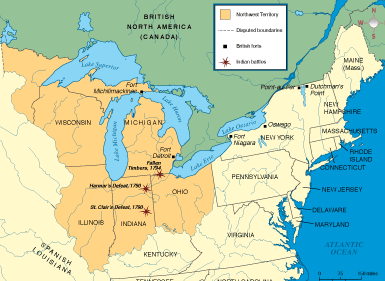|
Beyond Massachusetts, Rhode Island, and Connecticut
|
 |
| The following information is excerpted from the article, New England's Migration Fever: The Expansion of America – Ralph J. Crandall, Ph.D. Dr. Crandall is the executive director of the New England Historic Genealogical Society. The full article is available at Ancestry.com |
| After the American Revolution, two
distinct types of migration occurred. First, there was a steady
generational flow of New Englanders into the nearby states of New York and
Pennsylvania, and later into the other regions of the old Northwest
Territory. Hundreds of New England families began to move into the
northeastern counties of Pennsylvania after the Revolution, as well as the
northern and west-central counties of New York. This process of settlement
frequently took families fifty to seventy-five years and two or three
generations to move from a given area such as Vermont to Illinois.
The second type of migration occurred in sudden, massive spurts, often described as fevers: "Genesee Fever" in the mid-1790s; "Ohio Fever" after 1816; and "Oregon Fever" in the 1840s; and the California Gold Rush. When these fevers swept New England, families who had lived in one place for several generations might suddenly pull up stakes and leave for distant lands in the west. New Englanders migrated in large numbers to New York. First, the western shore of Lake Champlain and the older towns on the Hudson River were populated. Then, between 1800 and 1820, several thousand New England families settled in the northern New York counties of Essex, Clinton, Franklin, St. Lawrence, and Jefferson. Genesee County: In the 1790s, many New Englanders began moving to that region of New York known as the Genesee country. Located in west-central New York, the area contained over two million acres, which were ceded to Massachusetts in 1786 to settle an ancient land dispute. Massachusetts then sold this land to Oliver Phelps and Nathaniel Gorham for $100,000. Phelps and Gorham divided it into townships and began offering parcels to individuals in 160-acre tracts. Ohio Fever: Even as New Englanders were flocking to upstate New York and western Pennsylvania, others more daring were moving to Ohio. A large number of early Ohio settlers came from Germany or Northern Ireland. Bernard Bailyn in Voyagers to the West notes that between 1717 and 1760, 100,000 to 150,000 Scots-Irish arrived in the Port of Philadelphia. By the 1770s, the German and Scots-Irish were swarming into western Pennsylvania and down the Shenandoah Valley into Kentucky, Tennessee, and the Carolinas. Many ended this restless odyssey as squatters on lands north of the Ohio River.Settlements along the Ohio River did not, however, attract many New Englanders. They moved instead to an area in Ohio called the "Western Reserve," known in New England as New Connecticut. The Western Reserve is a narrow strip of land running west from the Pennsylvania border and paralleling Lake Erie, which the state of Connecticut withheld when all lands west of the Appalachian Mountains were turned over to the federal government. In 1795, Connecticut sold most of this land, approximately 3 million acres, to the Connecticut Land Company. New Englanders began moving to the Reserve in massive numbers only after the War of 1812, which had had a devastating economic effect on New England. The British had raided and sacked towns along the coast and held American ships in harbor. Foreign trade was ruined. New England was virtually bankrupt. Even as people were moving to Ohio, others were beginning to look beyond to more distant territories in the Old Northwest. New Englanders were attracted especially to Illinois, Michigan, and Wisconsin. And beyond the Mississippi River, several thousand New Englanders also settled in Iowa. The Erie Canal, which was opened in 1825, became the great highway from New England to the West. Manifests of canal boats in the 1830s often read, "Flour, wool, and hides eastbound, farmers westbound." In one month, four thousand farm families passed through the canal. Then, arriving in Buffalo, they boarded vessels to cross Lake Erie to Cleveland, Toledo, or Detroit then westward overland to Michigan, Wisconsin, or across the Mississippi into Iowa or points farther west. Oregon FeverAnother migratory trend that began in the 1830s and was in full swing a decade later was one that went to the Pacific territories of California and Oregon. By 1866 more than 350,000 men, women, and children had migrated to the far west. In one important aspect—distance—this migration was a new kind of enterprise. From jumping-off points along the Missouri River, towns like Independence, St. Joseph, and Council Bluffs, the destination was 2,400 miles away (unless the family was bound for Salt Lake City). The overland route stretched wider than the Atlantic Ocean. This long trek usually began in April and ended the following November in the Sacramento or Willamette Valley. California Gold Rush Two distinctive types of migration characterized the late eighteenth and nineteenth centuries. The first occurred in progressive stages and was really an extension of generational migration in the colonial period. Families moved literally step by step from, perhaps, Connecticut to New Hampshire to Vermont, then westward to New York or Pennsylvania, then Ohio, the Midwest, and sometimes, California and Oregon. The second pattern was Genesee, Ohio, Oregon, and California Gold Rush "fevers," which suddenly swept over New England, often stimulated by economic and climatic factors as well as the pioneering spirit and search for a better life that have since characterized Americans. Whichever way New Englanders migrated after the Revolution, they were a westward-minded, restless, and migrating people whose pathways have influenced the entire movement of the United States population. |